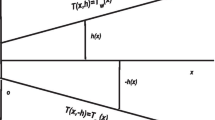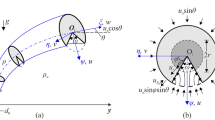Abstract
A vertical straight circular adiabatic vertical long tube, open at its lower and upper ends, is heated at its base on a short portion. The flow is studied with the hypothesis of no pressure drop between the entrance and the exit. Direct resolution of Navier Stokes equations is done by finite volumes. The numerical solutions are then compared to a one dimensional model and to two asymptotic models. The first asymptotic model is inspired from boundary layer approximations whereas the second one is more a linear perturbation of the Navier Stokes Boussinesq equations. For moderate values of the Grashof number, pressure, starting from zero decreases over the heated part to a minimum and increases on the adiabatic tube to zero. For larger values of Grashof, a local maximum in pressure appears, this pressure hump may even be positive. The four model agree, for moderate Grashof. When increasing the Grashof, only the two asymptotic models recover the behavior obtained from the numerical simulations.












Similar content being viewed by others
Abbreviations
- Gr :
-
Grashof (equivalent to Re due to the choice of scales)
- g :
-
Gravitational acceleration
- h :
-
Heat transfer coefficient
- k :
-
Thermal conductivity
- \(\ell\) :
-
Length of the heated part
- \(L_c\) :
-
Length of the adiabatic channel
- \({\bar{p}}\) :
-
Deviation of pressure from hydrostatic pressure without dimension
- Pe :
-
Péclet number
- r :
-
Radial variable
- R :
-
Radius of the channel
- Re :
-
Reynolds number
- S :
-
Section of the channel
- \({\bar{T}}_m\) :
-
Mean value of the temperature across a section ponderated by the Poiseuille solution
- \(T_0\) :
-
Reference temperature
- \(T_w\) :
-
Temperature of the heated part of the channel
- u :
-
Velocity along the tube
- \({\bar{U}}_{max}\) :
-
Maximum of the velocity without dimension
- \(\bar{U}\) :
-
Mean value of the velocity across a section
- \(U_0= (R^2\rho g \alpha (T_w-T_0))/\mu\) :
-
Velocity scale
- v :
-
Radial velocity across the tube
- x :
-
Axial direction along the tube
- \(\alpha\) :
-
Coefficient of thermal expansion
- \(\Delta T=(T_x-T_0)\) :
-
Driving difference of temperature
- \(\lambda\) :
-
A thermal length for the 1D model
- \(\mu\) :
-
Dynamic viscosity
- \(\nu\) :
-
Kinematic viscosity
- \(\rho _0\) :
-
Reference density of the fluid
- \(-\,\hat{}\,\sim\) :
-
Quantity without dimension
References
Pastohr H, Kornadt O, Gurlebeck K (2004) Numerical and analytical calculations of the temperature and flow field in the upwind power plant. Int J Energy Res 28:495–510
Sangi Roozbeh, Amidpour Majid, Hosseinizadeh Behzad (2011) Modeling and numerical simulation of solar chimney power plants. Sol Energy 85:829–838
Koonsrisuk A, Lorente S, Bejan A (2010) Constructal solar chimney configuration. Int J Heat Mass Transf 53:327–333
Koonsrisuk A (2012) Mathematical modeling of sloped solar chimney power plants. Energy 46:582–589
Tingzhen M, Wei L, Guoliang X (2006) Analytical and numerical investigation of the solar chimney power plant systems. Int J Energy Res 30:861–873
Chitsomboon T (2001) A validated analytical model for flow in solar chimney. Int J Renew Energy Eng 3(2):339–346
Padki M, Sherif SA (1999) on a simple analytical model for solar chimneys. Int J Energy Res 23:345–349
Leontiev A (1985) Théorie des échanges de chaleur et de masse. ed. MIR
Prandtl L (1952) Guide à travers la mécanique des fluides. Dunod
Lévêque A (1928) Les lois de la transmission de chaleur par convection. Ann. des Mines. XIII S. 201–299, 305–362 381–415
Lagrée P-Y (1999) Thermal mixed convection induced locally by a step in surface temperature in a Poiseuille Flow in the framework of Triple Deck. Int J Heat Mass Transf 42:2509–2524
Lagrée P-Y (2001) Removing the marching breakdown of the boundary layer equations for mixed convection above a horizontal plate. Int J Heat Mass Transf 44(17):3359–3372
Le Quéré P (2008) On the computation of some external or partially enclosed natural convection flows. In: Proceedings of the 19th international symposium on transport phenomena, 17–20 Aug 2008, Reykjavik, I
Desrayaud G, Chénier E, Joulin A, Bastide A, Brangeon B, Caltagirone JP, Cherif Y, Eymard R, Garnier C, Giroux-Julien S, Harnane Y, Joubert P, Laaroussi N, Lassue S, Le Quéré P, Li R, Saury D, Sergent A, Xin S, Zoubir A (2013) Benchmark solutions for natural convection flows in vertical channels submitted to different open boundary conditions. Int J Therm Sci 72:18–33
Garnier C, Sergent A, Le Quéré, Private communication
Gerris Flow Solver. http://gfs.sourceforge.net/wiki/index.php/Main_Page
Popinet S (2003) Gerris: a tree-based adaptive solver for the incompressible Euler equations in complex geometries. J Comput Phys 190(2):572–600
Lagrée P-Y, Staron L, Popinet S (2011) The granular column collapse as a continuum: validity of a Navier-Stokes model with a μ(I)-rheology. J Fluid Mech. doi:10.1017/jfm.2011.335
Pedley TJ (1980) The fluid mechanics of large blood vessels. Cambridge University Press, Cambridge 633p
Chouly Franz, Lagrée P-Y (2012) Comparison of computations of asymptotic flow models in a constricted channel. Appl Math Model 36:6061–6071
Lagrée P-Y, Lorthois S (2005) The RNS/Prandtl equations and their link with other asymptotic descriptions: application to the computation of the maximum value of the Wall Shear Stress in a pipe. Int J Eng Sci 43(3–4):352–378
Lagrée P-Y, Berger E, Deverge M, Vilain C, Hirschberg A (2005) Characterization of the pressure drop in a 2D symmetrical pipe: some asymptotical, numerical and experimental comparisons. ZAMM Z Angew Math Mech 85(2):141–146
Aung W, Fletcher L, Sernas V (1972) Developing laminar free convection between vertical flat plates asymmetric heating. Int J Heat Mass Transf 15:2293–2307
Lagrée P-Y (2010) Interactive Boundary Layers. In: Steinrück H (ed) Asymptotic methods in fluid mechanics: survey and recent advances, CISM courses and lectures, vol 523. Springer, Wien New York, pp 247–286. ISBN 978-3-7091-0407-1
Elenbaas W (1942) Heat dissipation of parallel plates by free convection. Physica 9(1):1–28
Garnier C, Sergent A, Le Quéré P (2013) Modélisation et influence des conditions limites pour des écoulements 2d semi-confinés. XIème Colloque Interuniversitaire Franco-Québécois sur la Thermique des Systèmes 3–5 juin 2013, Reims
Sun H, Li R, Chénier E, Lauriat G (2012) On the modeling of aiding mixed convection in vertical channels. Heat Mass Transfer 48(7):1125–1134. doi:10.1007/s00231-011-0964-8
Desrayaud G, Bennacer R, Caltagirone JP, Chenier E, Joulin A, Laaroussil N, Motjtabi K (2007) Etude numérique comparative des écoulements thermoconvectifs dans un canal vertical chauffé asymmétriquement. In: 8 ème Colloque Inter-Universitaire Franco-Québécois sur la Thermique des Systèmes, CIFQ2007/ART-06-14, 28–30 (Mai 2007)
Garnier C, Sergent A, Fraigneau Y, Le Quéré P (2014) Comparative study of numerical simulations of a 2d buoyancy-driven flow in a vertical channel asymmetrically heated with or without external domain. In: Proceedings of the 15th international heat transfer conference. Kyoto, Japan IHTC15-9291
Garnier C, Sergent A, Fraigneau Y, Le Quéré P. Etude numérique de l’interaction entre un canal vertical asymétriquement chauffé et son environnement extérieur.
Garnier C (2014) Modélisation numérique des écoulements ouverts de convection naturelle au sein d’un canal vertical asymétriquement chauffé. PhD Thesis University Paris-Sud Orsay
Cebeci T, Cousteix J (2005) Modeling and computation of boundary-layer flows, 2nd edn. Springer, Berlin
Acknowledgments
The authors wish to thank ENSTA Paristech (aka. Techniques Avancées) to provide links between them trough a series of courses of heat transfer at ENIT Tunis.
Author information
Authors and Affiliations
Corresponding author
Rights and permissions
About this article
Cite this article
Arfaoui, W., Safi, M.J. & Lagrée, PY. Buoyancy-aided convection flow in a heated straight pipe: comparing different asymptotic models. Heat Mass Transfer 52, 1515–1527 (2016). https://doi.org/10.1007/s00231-015-1677-1
Received:
Accepted:
Published:
Issue Date:
DOI: https://doi.org/10.1007/s00231-015-1677-1




